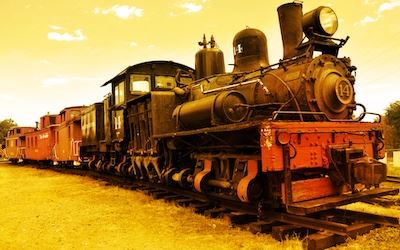 My grandfather owned a horse and a farm wagon, roughly the 1890s equivalent of the pickup truck of today. He traveled around the farming village where he lived at 3 or 4 miles per hour. When he needed to travel a longer distance, such as to the nearby city, he rode a train that reached speeds as high as 35 mph. Granddad never bought one of those new-fangled automobiles.
My grandfather owned a horse and a farm wagon, roughly the 1890s equivalent of the pickup truck of today. He traveled around the farming village where he lived at 3 or 4 miles per hour. When he needed to travel a longer distance, such as to the nearby city, he rode a train that reached speeds as high as 35 mph. Granddad never bought one of those new-fangled automobiles.
My father was of “the modern generation.” His first car was a well-used Model A Ford, and he went on to own an assortment of Fords, Plymouths, DeSotos, and Dodges over the years. Oh yes, one year when he worked a lot of overtime in the local factory, he bought a Cadillac. He drove most everywhere he wanted to go. He drove 50 or 60 miles an hour most everywhere. I don’t remember him ever taking a train.
Of course, I am of a still more “modern age,” and I love sports cars. I have owned a number of them, and I presently own a Corvette that is fast. Very fast. I am told it will travel 195 miles per hour although I cannot vouch for that from experience. Prior to that automobile, I owned others capable of similar speeds.
I used to commute to the city every day and sometimes drove a very powerful and very fast sports car to work every day, traveling down the local superhighway during the height of the rush hour. Many times I averaged 3 or 4 miles an hour for extended periods of time. The traffic into and out of the city often crawls at that speed for hours.
Driving a 6-speed manual transmission isn't much fun in stop-and-go traffic. I eventually gave up on driving the car to work. I started taking the train. The local commuter rail averages 35 mph on a daily commute.
I am more like my grandfather than I want to be.
Recently a researcher compared the travel times in the city of London through the years. He noticed that the amount of time it took to go from point A to point B in horse-and-buggy days was the same as it was after automobiles became common. Then he noticed that the time required today to travel the same routes is actually worse during rush hour than it was in horse-and-buggy days.
Newer and more efficient mechanisms attract throngs of people who then clog the system. The results nullify the improvements. The large amount of horse manure in the streets has been replaced by airborne hydrocarbons; both are unwanted byproducts of our transportation systems of the day.
Are we really better off?